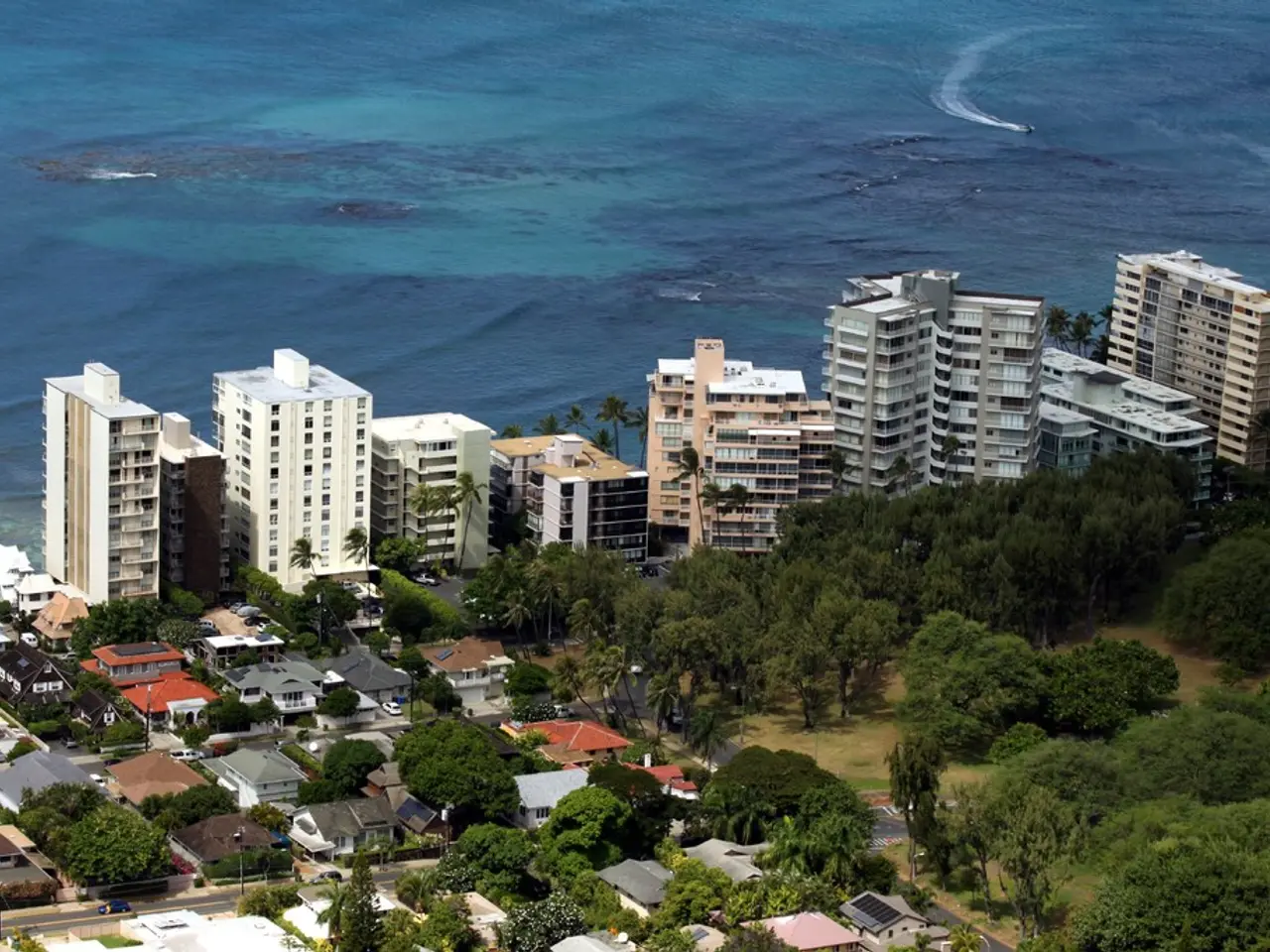Capital Market Stir: The debut of Blue Bonds causing a ripple effect
The blue economy, valued at around U.S.$1.5 trillion, is poised for significant growth, expected to double in size to U.S.$3 trillion by 2030, creating 40 million jobs, and becoming the eighth largest economy in the world with an estimated asset value of US$24 trillion [1]. This expansion is driven by the increasing popularity of blue bonds, a type of use-of-proceeds bond that finances marine and ocean-based projects, falling under the category of green or ESG bonds [2].
Blue bonds are seen as a way of addressing the underfunding of SDG 14 (life below water) and are consistent with the International Capital Markets Association's (ICMA) Green Bond Principles (GBPs) [3]. Key players like the United Nations, World Economic Forum, International Finance Corporation, and UN Global Compact provide guidance on issuing blue bonds and financing the sustainable blue economy [4].
According to UN-related guidance and authoritative sources, the process of issuing a blue bond typically involves several key steps [5]:
- Capacity Building: Strengthening the technical and institutional capacity of finance ministries, central banks, and regulators is essential to support the development and issuance of blue bonds.
- Framework Development: Establish a robust blue finance framework that aligns with recognized green and blue bond principles, such as the Green Bond Principles (GBP 2021) and IFC Guidelines for Blue Finance. This framework outlines eligible project categories, sustainability objectives, use of proceeds, and impact measurement.
- Stakeholder Coordination and Policy Alignment: Collaboration among government entities, development partners, and investors to ensure macro-fiscal alignment and coherence with national sustainable development goals and blue economy strategies is critical.
- Project Selection and Due Diligence: Identify and select credible projects that contribute to marine conservation, sustainable fisheries, or other blue economy priorities. These projects must comply with environmental and social standards and demonstrate measurable impact.
- Issuance and Market Entry Support: Design the bond issuance in adherence to international capital market standards (e.g., ICMA principles) and seek technical support for structuring, rating, and roadshows to attract investors. This includes transparency on use of proceeds and sustainability reporting commitments.
- Ongoing Monitoring and Reporting: Commit to transparent impact reporting and verification to maintain investor confidence and track contributions to blue economy outcomes.
- Policy and Institutional Embedding: Incorporate blue bond frameworks into broader industrial, environmental, and economic policies and consider establishing coordination platforms (e.g., regional observatories) for data and policy coherence to scale up blue finance.
Examples of projects financed by blue bonds include coastal ecotourism, sustainable energy, sustainable maritime transport, sustainable marine fisheries management, clean water and waste water management, and port infrastructure projects that prevent marine pollution [6]. Investors in blue bonds range from high-net-worth individuals to venture capital firms and investment banks.
The debt-for-nature swap structure, where a developing country's external debt is forgiven or reduced in exchange for local environmental conservation measures, has been utilized by several countries, including Seychelles, Indonesia, Colombia, Gabon, Belize, and Barbados to finance blue projects [7]. However, this structure is more complex and expensive to implement compared to the traditional use-of-proceeds blue bond structure.
As of July 2024, the blue bond market has grown significantly, reaching approximately U.S.$7.2 billion [8]. It's expected that blue bonds will continue to gain popularity as the demand for sustainable solutions grows [9]. Notable blue bond issuers include France's Saur Group and DP World, who issued blue bonds in October 2024 and December 2024, respectively, to support sustainable water management initiatives and marine practices [2].
In conclusion, blue bonds offer a promising avenue for financing the sustainable blue economy, with the potential to drive growth, create jobs, and protect marine ecosystems. By following UN guidance and best practices, issuers can ensure the success and impact of their blue bond initiatives.
References: [1] World Economic Forum. (2020). Blue bonds: Financing the sustainable blue economy. Retrieved from https://www.weforum.org/reports/blue-bonds-financing-the-sustainable-blue-economy [2] International Finance Corporation. (2020). Blue bonds: Financing ocean solutions. Retrieved from https://www.ifc.org/wps/wcm/connect/industry_ext_content/ifc_external_corporate_site/industry/financial_markets/ifc_financing_ocean_solutions [3] International Capital Markets Association. (2021). Green, Social and Sustainability Bond Principles 2021. Retrieved from https://www.icma.net/publications/green-social-and-sustainability-bond-principles-2021 [4] United Nations Development Programme. (2020). Blue bonds: Financing ocean solutions. Retrieved from https://www.undp.org/content/undp/en/home/ourwork/ocean/bluebonds.html [5] United Nations Development Programme. (2020). Blue bonds: Aligning with global standards and best practices. Retrieved from https://www.undp.org/content/undp/en/home/ourwork/ocean/bluebonds/aligning-with-global-standards-and-best-practices.html [6] World Bank. (2020). Blue bonds: Financing ocean solutions. Retrieved from https://www.worldbank.org/en/topic/oceansandcoasts/brief/blue-bonds-financing-ocean-solutions [7] International Finance Corporation. (2020). Debt-for-nature swaps: A growing trend in ocean finance. Retrieved from https://www.ifc.org/wps/wcm/connect/industry_ext_content/ifc_external_corporate_site/industry/financial_markets/debt-for-nature-swaps-a-growing-trend-in-ocean-finance [8] Climate Bonds Initiative. (2022). Blue Bond Market Analysis 2022. Retrieved from https://www.climatebonds.net/market-insights/blue-bond-market-analysis-2022 [9] International Finance Corporation. (2020). Blue bonds: The future of ocean finance. Retrieved from https://www.ifc.org/wps/wcm/connect/industry_ext_content/ifc_external_corporate_site/industry/financial_markets/blue-bonds-the-future-of-ocean-finance
- The growth of the blue economy presents a significant investment opportunity for environmental-science enthusiasts, as it is projected to double in size to $3 trillion by 2030, featuring the development of projects like sustainable marine fisheries and clean water management, funding for which can be sourced through blue bonds.
- As the demand for sustainable solutions escalates, finance and business sectors play a crucial role in supporting the blue economy by investing in blue bonds, following international guidelines such as the Green Bond Principles, ensuring that the funds are utilized for marine and ocean-based projects, contributing to climate-change mitigation and preserving the environment.
- There is a promising intersection between technology and the blue economy, as technological advancements can facilitate the successful issuance and management of blue bonds, helping to establish a robust blue finance framework that aligns with recognized principles, enabling effective collaboration among stakeholders, and ensuring transparent impact reporting, ultimately contributing to sustainable ocean solutions.




